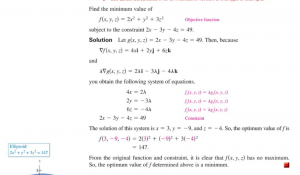
What is the maxima of a function?
What are the Maxima and Minima of a Function? The maxima of a function is the highest point on the graph of the function. In other words, it is the point at which the function reaches its maximum value.
The maxima of a function can be found by taking its derivative and setting it equal to zero. This will give you the x-coordinate of the maxima. You can then plug this x-coordinate back into the original function to find the y-coordinate of the maxima.
The maxima of a function can also be found by looking at its graph. To do this, you need to find the points where the graph changes from concave up to concave down. These points will be the maxima of the function.
You can also use the second derivative test to find the maxima of a function. This test involves taking the second derivative of the function and setting it equal to zero. If the second derivative is positive at this point, then the point is a local maxima. If the second derivative is negative at this point, then the point is a local minima.
The second derivative test can be used to find both the local maxima and the global maxima of a function. Global maxima are the highest points on the graph of the function, while local maxima are the highest points within a certain region.
The maxima and minima of a function can also be found by looking at its graph. To find the maxima, you need to find the points where the graph changes from concave up to concave down. These points will be the maxima of the function.
Also read: Integral calculus: Definition, formulas, types, and examples
How to Find the Global Maxima?
To find the global maxima, you need to take the derivative of the function and set it equal to zero. This will give you the x-coordinate of the maxima. You can then plug this x-coordinate back into the original function to find the y-coordinate of the maxima.
What is the Saddle Point?
The second derivative test can also be used to find saddle points. Saddle points are points where the graph of the function changes from concave up to concave down.
How to Find the Saddle Point?
To find saddle points, you need to take the second derivative of the function and set it equal to zero. If the second derivative is positive at this point, then the point is a local maxima. If the second derivative is negative at this point, then the point is a local minima. Saddle points are important because they can be used to optimize functions.
How to Optimize a Function?
To optimize a function, you need to find the point where the function reaches its maximum or minimum value. The maxima of a function is the highest point on the graph of the function, while the minima is the lowest point on the graph of the function. To find the maxima of a function, you need to take its derivative and set it equal to zero. This will give you the x-coordinate of the maxima. You can then plug this x-coordinate back into the original function to find the y-coordinate of the maxima.
What is the minima of a function?
The minima of a function can be found by taking the derivative of the function and setting it equal to zero. This will give you the x-coordinate of the minima. You can then plug this x-coordinate back into the original function to find the y-coordinate of the minima.
How to Find the Minima of a Function?
To find the minima, you need to find the points where the graph changes from concave down to concave up. These points will be the minima of the function. You can also use the second derivative test to find the maxima and minima of a function.
This test involves taking the second derivative of the function and setting it equal to zero. If the second derivative is positive at this point, then the point is a local maxima. If the second derivative is negative at this point, then the point is a local minima.
The second derivative test can be used to find both the local maxima and the global maxima of a function. Global maxima are the highest points on the graph of the function, while local maxima are the highest points within a certain region. To find the global minima, you need to take the derivative of the function and set it equal to zero.
This will give you the x-coordinate of the minima. You can then plug this x-coordinate back into the original function to find the y-coordinate of the minima. The second derivative test can also be used to find saddle points. Saddle points are points where the graph of the function changes from concave up to concave down.

How to Find Minima and Maxima in Polynomial?
To find the minimum and maximum values of a polynomial, you need to take the derivative of the polynomial. The derivative will tell you how the function is changing at that point. If the derivative is positive, then the function is increasing. If the derivative is negative, then the function is decreasing. To find the minimum value, you want to find the point where the derivative is zero. To find the maximum value, you want to find the point where the derivative is undefined.
You can also use calculus to find the minimum and maximum values of a polynomial. Calculus is a branch of mathematics that deals with derivatives and integrals. To find the minimum and maximum values of a polynomial, you need to take the derivative of the polynomial. The derivative will tell you how the function is changing at that point. If the derivative is positive, then the function is increasing. If the derivative is negative, then the function is decreasing. To find the minimum value, you want to find the point where the derivative is zero. To find the maximum value, you want to find the point where the derivative is undefined.
Also read How to determine the inverse of a function give an example?
Example for Finding the Maxima and Minima of a Function
We will use the function:
f(x) = x^(−sin(x))
The domain of this function is all real numbers. The range is all positive real numbers. To find the critical points of this function, we take the derivative:
f ‘(x) = -cos(x)*x^(-sin(x)) – sin(x)*ln(x)*x^(-sin(x))
Setting this equal to zero and solving for x gives us:
cos(x) = 0 OR sin(x)*ln(x) = 0
Thus, the critical points are: x=0, π/n, (n is any integer).
To find the maxima and minima, we need to look at the second derivative:
f ”(x) = sin(x)*cos(x)*x^(-sin(x)) – ln(x)*cos(x)*x^(-sin(x)) – sin(x)*ln(x)^(−sin(x)) – sin(x)*ln(x)*(-sin(x))*x^(-sin(x)-
The second derivative will be zero at the same points as the first derivative. However, we can also have a critical point where the second derivative is undefined. This will happen when:
sin(x)*ln(x) = 0 AND cos(x) = 0
This can only happen at x=0. To test if this is a maxima or minima, we take the limit as x approaches zero from both sides. We get:
lim f ‘(x) = lim -cos(x)*x^(-sin(x)) – sin(x)*ln(x)*x^(-sin(x))
= -∞ + 0
= -∞ (from the left) OR 0−∞ (from the right)
Thus, we have a minimum at x=0.
Now, we need to test the other critical points to see if they are maxima or minima. We do this by plugging in the values of x and taking the second derivative. If the second derivative is positive, it is a minimum. If the second derivative is negative, it is a maximum. If the second derivative is undefined, we take the limit as x approaches the critical point from both sides to see if it is a maxima or minima.
For x=π/n:
f ”(x) = sin(x)*cos(x)*x^(-sin(x)) – ln(x)*cos(x)*x^(-sin(x)) – sin(x)*ln(x)^(−sin(x)) – sin(x)*ln(x)*(-sin(x))*x^(-sin(x)-
= 0 * cos((π/n)) * (π/n) ^ (-sin((π/n))) – ln((π/n)) * cos((π/n)) * (π/n) ^ (-sin((π/n))) – sin((π/n)) * ln((π/n))^(-sin((π/n))) – sin(x)*ln(x)*(-sin(x))*x^(-sin(x)-
= 0
Thus, we have a minimum at x=π/n.
For x=(n is any integer):
f ”(x) = sin(x)*cos(x)*x^(-sin(x)) – ln(x)*cos(x)*x^(-sin(x)) – sin(x)*ln(x)^(−sin(x)) – sin(x)*ln(x)*(-sin(x))*x^(-sin(x)-
= 0 * cos((n is any integer)) * (n is any integer) ^ (-sin((n is any integer))) – ln((n is any integer)) * cos((n is any integer)) * (n is any integer) ^ (-sin((n is any integer))) – sin((n is any integer)) * ln((n is any integer))^(-sin((n is any integer))) – sin(x)*ln(x)*(-sin(x))*x^(-sin(x)-
= 0
Thus, we have a minimum at x=(n is any integer).
We have now found all the maxima and minima of the function. We have one maximum at x=0 and an infinite number of minima at π/n and (n is any integer).
Also check